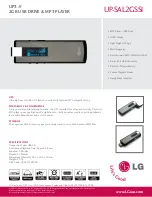
S E T U P M E N U O P T I O N S
31
7.
Speaker Test Tone (UBR-X200) :
Test tones are artificially-created sounds that are used to test your
audio speaker system and help to identify any wiring faults. Please note these test tones only work with the
multi-channel analogue audio outputs and are only suitable for channel identification purposes. For
comprehensive speaker configuration, we recommend using the dedicated test tones found on
professional audio calibration discs. To begin the test, press the
OK
button. Press the
RETURN
button to
exit.
The following speaker parameters can be configured:
1.
Size
: The following speaker size parameters control bass filtering for the speakers.
•
Large
– All audio content is passed to the appropriate speaker.
•
Small
– All audio content, except for bass frequencies, is passed to the appropriate speaker. The
purpose is to reduce possible distortion. If a subwoofer is available, bass frequencies are re-directed to
the subwoofer, otherwise, they are discarded.
NOTE
•
The
Size
for Front, Surround and Surround Back speakers is configured in pairs. Changes to
the size of one speaker will automatically change the other of the pair.
2.
Trim
: The speaker trim level parameters sets the volume of each individual channel. Channel trim is
generally not required since most A/V receivers have the capability to adjust channel trim and compensate
for speaker sensitivity differences. However, if your receiver does not have such functions (many receivers
do not support channel trim for their multi-channel analogue inputs), you may adjust channel trim through
the player. The trim level can be set to +/- 10dB in 0.5dB increments.
NOTE
•
Increasing the
Trim Level
above 0dB may result in distortion if the original audio level is already
high. When this occurs the waveform becomes clipped and audible distortion can be heard. In
this situation, it is necessary to reduce the
Trim Level
until the distortion is removed. When
using the
Trim Level
for speakers, it is recommended that you set the least sensitive speaker’s
Trim Level
to 0dB, and set other speakers’
Trim Level
to negative values.
•
Each speaker can be set to independent trim levels and there is no linked pair limitation.
3.
Distance
: The speaker distance parameters set delay control for the corresponding audio channel. The
delay is to compensate for the audio propagation time difference caused by the placement of speakers.
Speaker distance compensation is not required if the A/V receiver has the capability to adjust channel
delay and compensate for speaker distance differences. However, if your receiver does not have such
functions (most receivers do not offer these functions for their multi-channel analogue input), you may
adjust them through the player. Speaker distance delay is only applied if the player is decoding multi-
channel audio. If you use bitstream audio output to your A/V receiver, the bitstream audio is not adjusted
for speaker distance delay.
















































